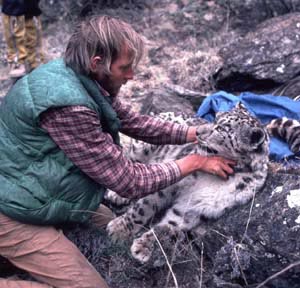Radio Collaring Snow Leopards

In 1981, Dr. Rodney Jackson and Darla Hillard traveled to the Langu Gorge of Nepal to conduct a study of snow leopards in their native habitat. At that time, very little was known about snow leopards in the wild. Rodney Jackson wanted to put radio collars on snow leopards so that he could track them and learn about their habits and their interaction with other members of their species. No one had ever put a radio collar on a snow leopard before. Many of Rodney’s fellow scientists thought it was far too difficult and that he would fail.
Darla wanted to go on the journey because she was certain they would have exciting adventures and important stories to tell when they got back.
Darla was right; they had plenty of adventure. The first season, though they experienced one of the worst winters in Nepal in decades, Rodney was able to attach a radio collar to one snow leopard, a cat he then called Ek, the Nepali word for “number one”. He had shown it was possible to put radio collars on snow leopards.

In later seasons, Rodney, with the help of Darla and another wildlife biologist, Gary Ahlborn, was able to radio collar four more snow leopards and get the scientific data he needed. He also succeeded in capturing the first camera-trap photos of snow leopards in the wild. Darla wrote about their adventures in her book Vanishing Tracks; Four Years Among the Snow Leopards of Nepal. Your local library will have a copy if you would like to read more about this exciting adventure.
At the top of the page is a picture of Rodney with “Tin” (Nepali for “three”). Tin also appears at the bottom of the page wearing his new radio collar. He has tried to leap away after the experience, but he is still somewhat sedated so he tumbles onto his back.